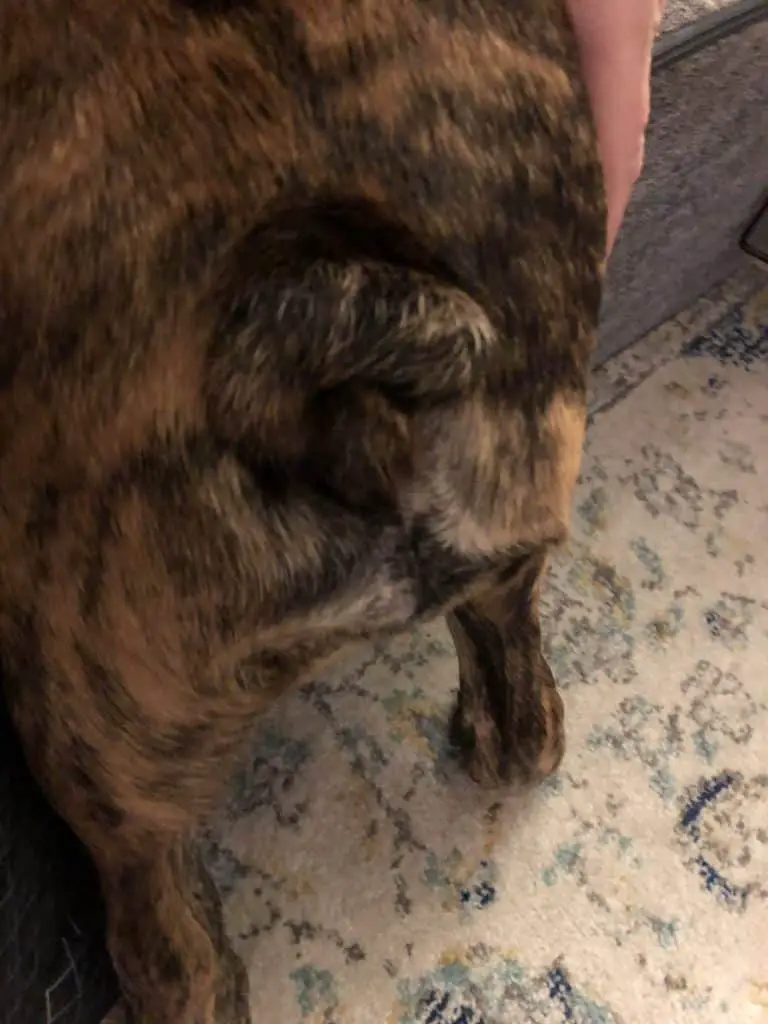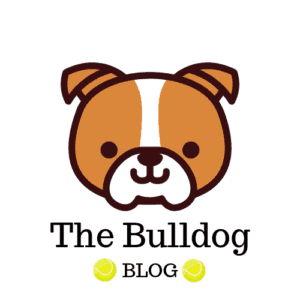When you are out and about, if you are lucky, you will spot a bulldog. As it passes you may notice there isn’t much of a tail. This could make you wonder if bulldogs have tails?
Bulldogs have tails and they are about one inch in length. Bulldog tails come in a variety of shapes and sizes, some are longer than an inch and others are so short it looks like there is no tail at all. Bulldog tails can be screw-shaped, others may have a bit of a curve, and some might be straight.

Are bulldogs born with tails, are they docked?
While it’s not always easy to know what your dog is thinking about or feeling, one sign we all know is that a wagging tail is a happy doggy. Bulldogs, however, have such small tails that they show their happiness and joy by wiggling their whole butt. When looking at their little shaking butts, some might wonder: are bulldogs born with longer tails that are docked when they’re young? Or are they just naturally born with little tails.
Bulldogs are one of the few dog breeds that are born without a sizable tail. When you see them for the first time, it might seem that their tails are docked, but that is not the case. There is just not an adequate tail for you to recognize.
Bulldogs typically have three styles of nubbin tails:
1. Straight tail – The straight tails are rather soft to touch, and they often taper down to a triangle-shaped tip.
2. Corkscrew tail – The corkscrew tail happens to be flexible in nature and it has an appearance as though it is wrapped, much like a pig’s tail.
3. Wavy or longer tails – This type is often longer than the other two and it points downward.
Why do bulldogs have tails?
Bulldogs have tails to communicate with other dogs. Even though they are small and less expressive compared to other breeds of dogs they still communicate using their little nubbin of a tail. If you look closely you can see when their stubby tails are raised up, tucked down on top of the butt, or in the air depending on their mood.
What are the different types of bulldog tails?
We all know bulldogs for their rather stocky and sturdy physic plus flat noses. However, one other notable aspect of their body is their tail. Below are detailed descriptions of the various tail types:
1. Straight tail
Once a puppy is born, the tail of that pup will start resembling what it will look like when he becomes an adult. As per the American Kennel Club, the corkscrew-shaped tails and the straight ones are the most common as well as the most desirable. A straight tail will be just that, straight.
2. Corkscrew tail
Corkscrew tails are very common in bulldogs. These tails are going to wrap downwards from the base and don’t extend upward. Although the corkscrew tails seem to be wrapped while the bulldog is born, it is flexible in nature. When the puppies slowly start to mature, their tails will become stiff in the same position appearing almost like little cinnamon rolls at the back of the bulldog.
3. Wavy or longer tails
According to the American Kennel Club, if the tails of the bulldogs happen to be wavy and long in nature, they may be considered faulty., as per the official standards of the bulldog breed. In reality, there is nothing technically wrong with your dog, it is just an imperfection.
Do all bulldog breeds have short tails?
Yes, they do, they’re bred to produce short, cute, and stumpy small tails, which exposes their butt most of the time.
How to take care of your bulldog’s tail
Bulldogs that have an extremely tight corkscrew tail might face some challenges in the warm weather when the tail part can become damp, which can cause soreness. For that reason, it is a good idea to wipe down that areas often, and keep it as dry as possible to avoid any discomfort.
In some rare circumstances, the vet might decide to remove the bulldog’s tail so as to stop any further complications.
How to treat Bulldog tail infections?
Bulldogs often have sensitive skin, and their tails are no different, and can be susceptible to getting red and itchy. Bulldogs with corkscrew-shaped tails and generally longer tails are especially vulnerable to infections.
If the bulldog’s tail blocks his/her anus, the bulldog might be prone to infections, that can become worse because of the feces and fluids that can build up. Bulldogs can suffer from yeast infection inside their tail pocket if they have one (Click here to see our comprehensive post on tail pockets and how to care for them).
If the tail pocket gets infected, your bulldog will lick and chew their rear areas without any shame. These types of infections can also emit a foul-smelling odor in the long run. If you believe your bulldog has developed an infected tail pocket consult your vet immediately for professional care.
Here are some methods for treating these infections effectively. At first, clip the fur which surrounds the infected region. Fur always encourages the development of infectious materials. You must try to eliminate it as soon as possible so that it does not lead to any further infection. This will also make it easy to continue the therapy for the well-being of the bulldog.
Gently wash the location with the help of antiseptic soap, and then blot completely dry.
Apply a washcloth on the affected region after soaking it in warm water. The blood antibodies will be drawn out by the heat and this will assist in effectively combating the infection. The warm washcloth must be applied to the skin of the furry animal for approximately 5 minutes until the cloth becomes cool. This process can be repeated several times every day until you notice that the area has started to heal.
If the tail infection of the bulldog is quite bad and you are not able to treat it on your own, then do not hesitate to take your pet to the vet who will be the best person to help you in this matter, as it might be that your bulldog needs antibiotics to fight off the infection.
How to clean a Bulldog’s tail pocket?
By the term “tail pockets”, we refer to a small indented region beneath the tail. While some bulldogs have a pocket under their tail, others might not have one at all.
This area can start developing grime and dirt buildup in the long run and this can make them infected and inflamed as a result. However, cleaning on a regular basis will help to prevent any type of discomfort and infection.
1. Clean the infected area
Make use of a moist and durable paper towel for cleaning the infected area carefully while removing grime gently at the same time. Try to be extremely gentle while doing so because the puppy is rather sensitive in this area. Go on cleaning till there is no visible indication of grime left in the area at all.
2. Make the area dry
It is possible for moisture to encourage the development of bacteria and cause infection in the long run. Make use of a dry and durable paper towel for gently patting around the area to absorb any moisture.
3. Take preventative steps
Since it is possible for tail pockets to become infected easily, it is advisable to use a diaper rash ointment. Consult your vet for a referral on the appropriate brand. Apply a small amount of that ointment on the tail pocket to keep that area clean and rash-free.
4. Keep the area dry
It is important to keep the area dry and free from moisture to ensure it’s free of infections. If the area does become infected, you can apply a medicated powder as recommended by your vet to the infected region to help keep it dry. At times, the powder might dissolve, or it might need removal during the subsequent cleaning session.
While cleaning the infected tail pocket, it is natural for owners to feel rather nervous. If you think that you have done something wrong, always make it a point to talk to your vet without hesitation. The area requires cleaning on a regular basis.
If you tend to ignore the tail pocket area while taking care of your lovable pup, it is possible for this area to become quite irritated in the long run and it can further develop dry or raw patches over time. Therefore, whenever you see any evidence of irritation or redness in that region, take him to the vet immediately for treatment.
All bulldogs have tails, some might be very short to the point where it’s almost not a tail at all. Others will be straight, corkscrewed, or even wavy. Some bulldogs will have a little tail pocket under there tail. All bulldogs are a little different which makes them each special in their own unique way. We hope this post helps you with taking care of your bulldog tail, short or long.
